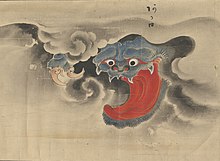
The nuppeppō is a yōkai that appears in Edo Period yōkai emaki such as the Gazu Hyakki Yagyō and the Hyakkai Zukan. It is depicted with indistinguishable wrinkles on its face and body as a one head blob of meat.

Kasa-obake are a mythical ghost or yōkai in Japanese folklore. They are sometimes, but not always, considered a tsukumogami that old umbrellas turn into. They are also called "karakasa-obake" (から傘おばけ), "kasa-bake" (傘化け), and "karakasa kozō" (唐傘小僧).

Chōchin'obake or chōchin-obake is a Japanese yōkai of chōchin, "[the] lantern-spook ... a stock character in the pantheon of ghouls and earned mention in the definitive demonology of 1784". They can also be called simply chōchin, bake-chōchin, obake-chōchin, and chōchin-kozō.

The akaname is a Japanese yōkai depicted in Toriyama Sekien's 1776 book Gazu Hyakki Yagyō, with its precursor or equivalent akaneburi documented earlier in 1686.

Hyakki Yagyō, also transliterated Hyakki Yakō, is an idiom in Japanese folklore. Sometimes an orderly procession, other times a riot, it refers to a parade of thousands of supernatural creatures known as oni and yōkai that march through the streets of Japan at night. As a terrifying eruption of the supernatural into the real world, it is similar to the concept of pandemonium in English.
Gazu Hyakki Yagyō is the first book of Japanese artist Toriyama Sekien's famous Gazu Hyakki Yagyō e-hon tetralogy, published in 1776. A version of the tetralogy translated and annotated in English was published in 2016. Although the title translates to "The Illustrated Night Parade of a Hundred Demons", it is based on an idiom, hyakki yagyō, that is akin to pandemonium in English and implies an uncountable horde. The book is followed by Konjaku Gazu Zoku Hyakki, Konjaku Hyakki Shūi, and Gazu Hyakki Tsurezure Bukuro.
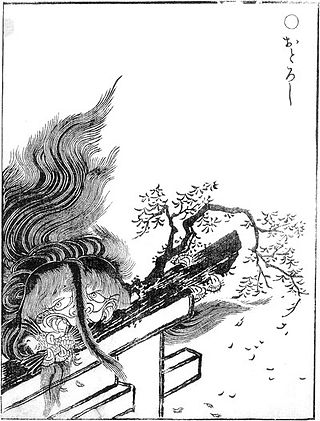
Otoroshi are a Japanese yōkai that appear in several yōkai emaki, such as the Hyakkai Zukan by Sawaki Suushi and the Gazu Hyakki Yagyō by Toriyama Sekien (1776).

An uwan (うわん) is a Japanese yōkai depicted in Edo Period pictures such as the Hyakkai Zukan by Sawaki Suushi and the Gazu Hyakki Yagyō by Sekien Toriyama.

Satori in Japanese folklore are mind-reading monkey-like monsters ("yōkai") said to dwell within the mountains of Hida and Mino.

Nurarihyon is a Japanese yōkai.
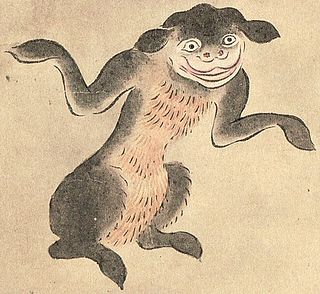
Yamabiko is a mountain god, spirit, and yōkai in Japanese folklore; the term "yamabiko" also refers to the echo that occurs in mountains, after which the yōkai is named. Literally translated, the term means "mountain boy". It is the yōkai responsible for the natural phenomenon in mountains or canyons. Living deep in the mountains, direct encounters with the yamabiko are rare. Often they are heard, but never seen. The small and elusive yokai wasn't officially classified until the Edo period in Japan. Instead the bizarre noises coming from the mountain were attributed to a natural phenomenon, like birds, and not given any spiritual significance. It is usually depicted with gray fur, peach-colored belly, floppy ears, large grin, and arms outstretched as though it is caught mid-shrug.

The Nuribotoke (塗仏) is a yōkai found in Japanese yōkai emaki such as the Hyakkai Zukan by Sawaki Suushi. They are also depicted in the Gazu Hyakki Yagyō by Toriyama Sekien.

Tenome is a Japanese yōkai that appeared in the Gazu Hyakki Yagyō by Toriyama Sekien.

Umi zatō (海座頭) is a Japanese yōkai, or supernatural being, in the Gazu Hyakki Yagyō by Toriyama Sekien and in various emakimono such as the Matsui Library's Hyakki Yagyō Emaki.
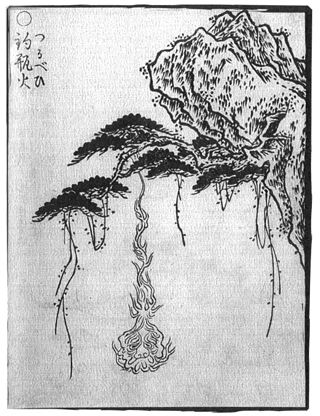
The tsurubebi is a fire yōkai that appears in the Gazu Hyakki Yagyō by Toriyama Sekien.
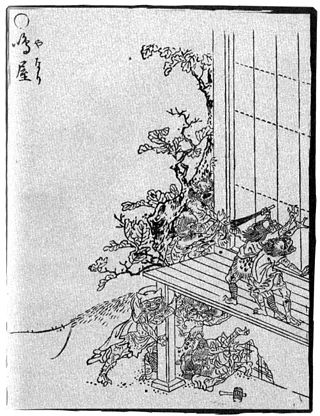
Yanari is a paranormal phenomenon told about in legends in various places in Japan where the house or furniture would start shaking for no reason.

The noderabō is a Japanese yōkai from Toriyama Sekien's Gazu Hyakki Yagyō and is thought to be a yōkai that appears at abandoned temples.

The ouni (苧うに) is a yōkai depicted in the Gazu Hyakki Yagyō by Toriyama Sekien.

The Shōkera is a Japanese yōkai found in Edo Period yōkai emaki such as, the Hyakkai Zukan and the Gazu Hyakki Yagyō. They can also be written しゃうけら, せうけら, as well as 精螻蛄.
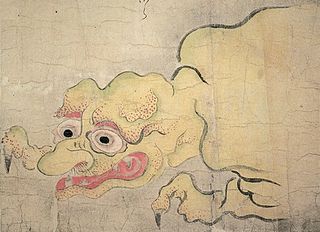
The waira (わいら) is a Japanese yōkai from Japanese emaki such as the Hyakkai Zukan by Sawaki Suushi and the Gazu Hyakki Yagyō (1776) by Sekien Toriyama.

